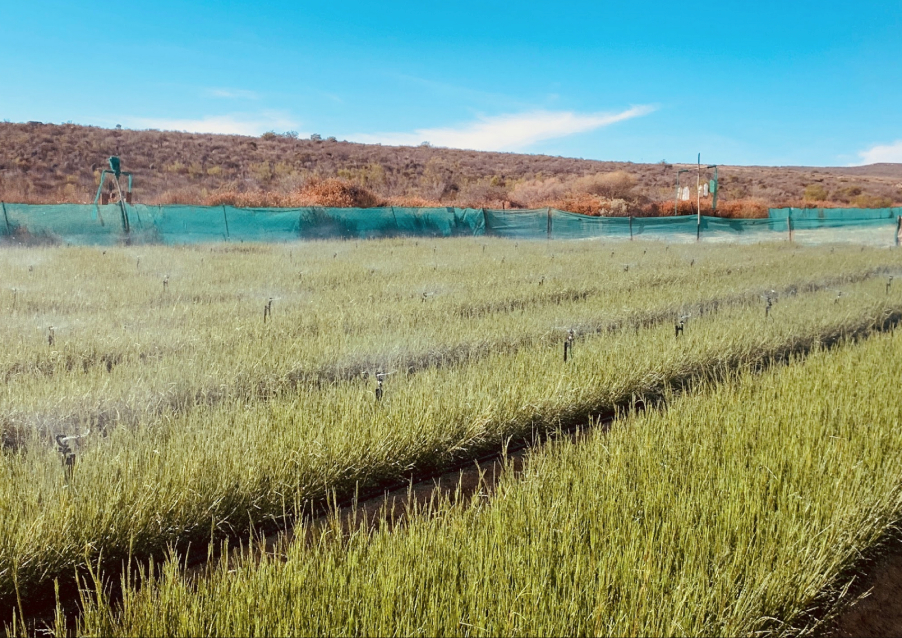Interest in rooibos as a plant is growing globally, and has been on the increase for over two decades. In this period, attempts have been made to grow the plant in a variety of countries across the world, but to date none have been commercially successful. Rooibos only grows in one part of the world, the Cederberg region of South Africa, which remains the only part of the world where rooibos is commercially viable. This raises the question: ‘Why is rooibos only grown in South Africa?’.
The answers to this question most likely lie in a number of factors related to soil and climate, though there may very well be additional factors which have yet to be identified. There are also various factors which would most likely make ventures in commercial production outside of South Africa unsuccessful. These are discussed towards the end of this article.
In terms of soil biology, much might be attributed to the unique combination of micro-organisms that exist in just the right balance within the rooibos growing region. Another significant factor is that unusually, rooibos is an acidophilic plant, in that it prefers a very acidic soil. It’s thus likely that anything other than the right soil pH range and type may play a role in impeding its cultivation in other parts of the world. Providing the right environment, the acidic soil that rooibos thrives in is host to an indigenous mycorrhizal community which may be difficult to replicate outside of the sandy eroded sandstone geology typical to the Cederberg and surrounding area.
Though it is foreseeable that inoculation of an acidic soil (with all other necessary characteristics) with a sample of Cederberg soil might give rise to a proliferation of the right soil microbiome, this is far from certain.
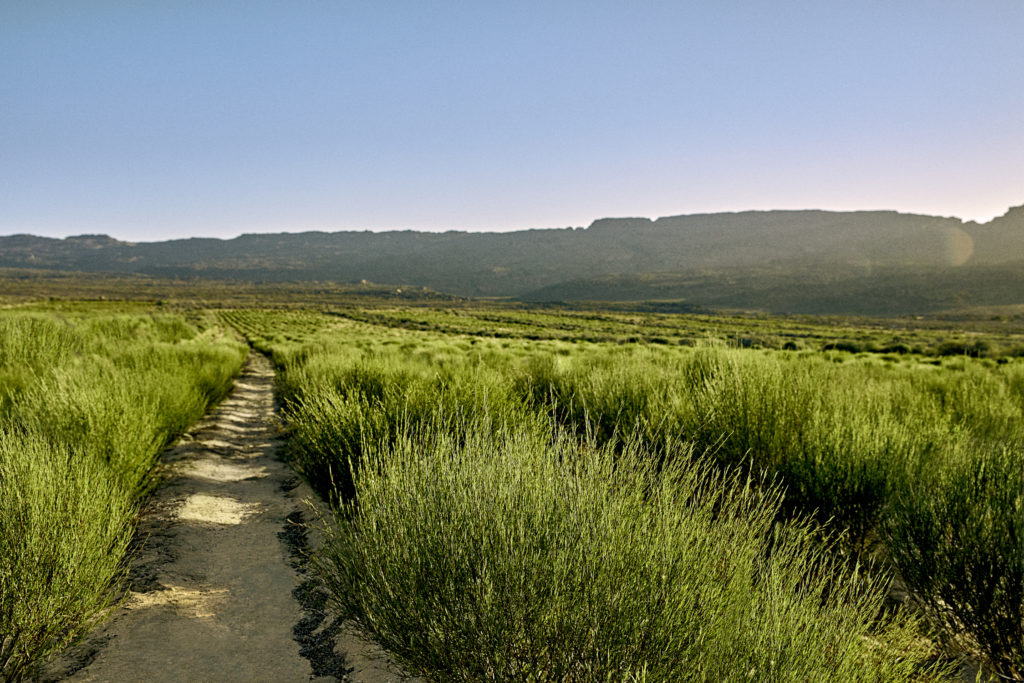
Climate, Soil and a Unique Terroir
An additional factor that may have played a role in the failure of attempts to grow rooibos elsewhere in the world could be climate. The rooibos region experiences a wet season that spans the southern hemisphere’s winter and spring, and a dry season that is typically very hot and usually lasts the six months from November to April. If the rainfall and soil conditions are not generally matched to the plant’s needs, chances are that rooibos may not establish well enough to thrive.
A further factor related to climate and rainfall could be related to humidity levels: were the plant grown in a summer rainfall area with higher levels of humidity as a result of high temperatures, it follows that this would provide a fertile environment for fungi of types that rooibos has not evolved to adapt to.
What is known is that rooibos grows in a nutrient-poor and very well-drained soil. If the soil type chosen for cultivation were too high in organic matter or moisture, this may create conditions supportive of opportunistic fungi, leading to diseases in the root system. This would in turn likely create issues with the rooibos’ reliance on a healthy soil community, which could easily be affected by fungi that are not compatible with the rhizobia (the scientific name for bacteria of the type that convert atmospheric nitrogen into soil nutrients) that make the soil environment suitable for rooibos’ particular needs.
The very specific combination of the rooibos-growing region’s climate, soil and micro-organisms make for a unique terroir which, much like in the wine industry, is known to play a significant role in determining the taste, colour and aroma of a high-quality product.
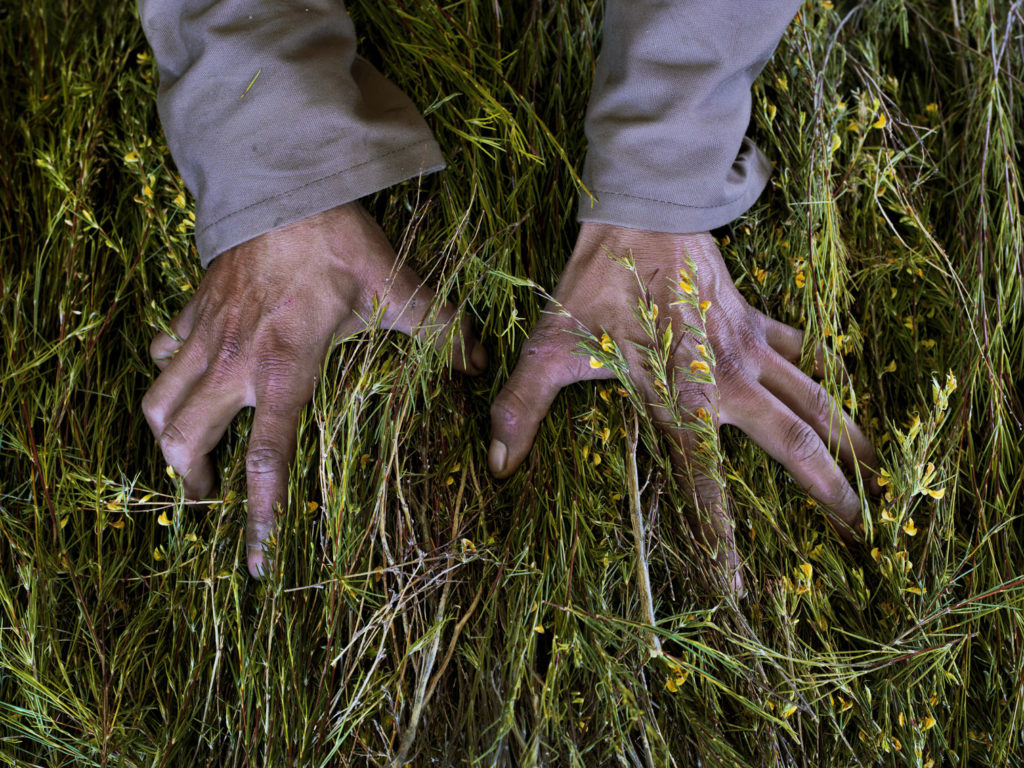
Rooibos as a Legume: Could This Be a Factor?
Though not many people outside of the rooibos industry are aware of it, the rooibos plant is in fact a legume (and the cultivated type is but one of over 270 types in its family, whose genus belongs to the subfamily Faboideae). That rooibos is a legume is something that is quite apparent once the flowers of a rooibos plant (botanical name Aspalathus linearis) are observed. From spring into summer, dainty yet distinctive yellow flowers appear and set seed with the help of local pollinators.
One look at the distinctive shape of a rooibos flower by a gardener or plant lover is all it would take to confirm that this is a plant in the pea and bean family. And it’s in its leguminous nature that the secret to rooibos cultivation may lie, because it has long been known that legumes benefit from a symbiotic relationship with bacteria and fungi in the soil. The result are what’s known as nitrogen-fixing nodules, which grow on the roots of legumes and produce nitrates that are made available to the plant’s root system. For rooibos, this critical survival technique enables it to thrive in the sandy and nutrient-poor soil found in its home range.
Research that has sought to identify the balance of microorganisms in the soil that rooibos grows in is relatively limited, though published papers from agricultural scientists in South Africa do provide some clues: “Genera that are regularly isolated from rooibos and honeybush root nodules include Rhizobium, Burkholderia, Mesorhizobium and Bradyrhizobium. These species produce bioactive compounds that directly or indirectly affect growth of leguminous plants.”(1)
Those four rhizobia are what are well-known to researchers at this time, but the chances are good that there may be many more involved in the unique complex that supports the growth of the rooibos plant in its endemic growth region.
Soil biology is an ever-expanding field of study, and as greater attention is turned towards organic farming methods such as those which we use here at Klipopmekaar, so researchers are discovering a greater complexity to the scale and type of organisms which populate each distinct climate and habitat.
For rooibos, this is of particular importance, growing as it does in a very specific type of soil. You could say that, like those who love and drink rooibos, the plant itself has an acquired taste.
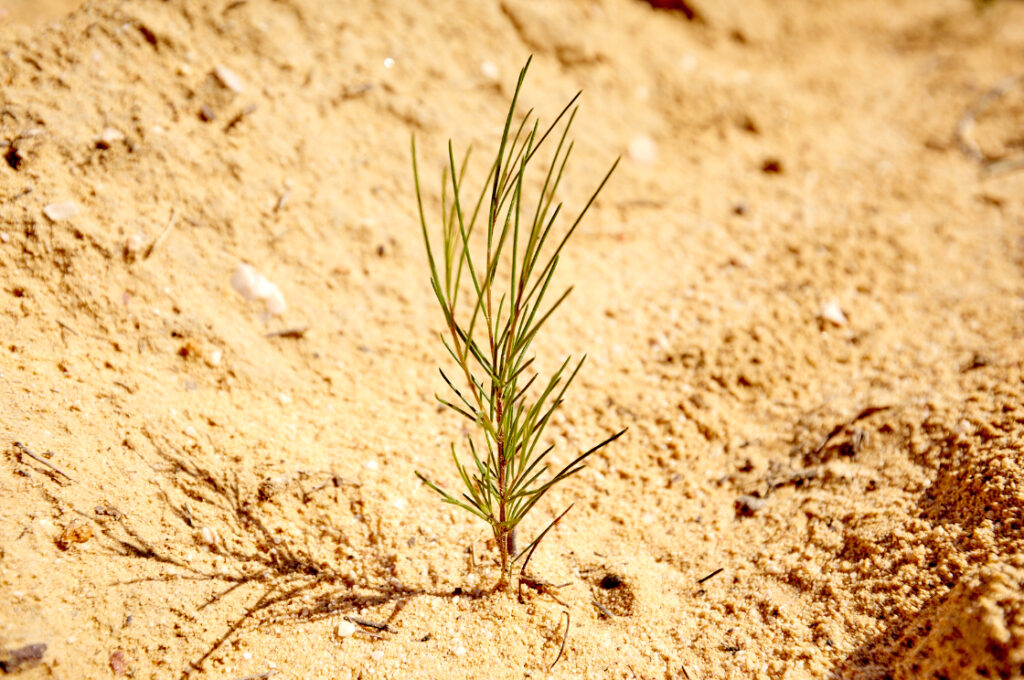
The Mycorrhizal Complex: Another Factor In Play?
Research into the mycorrhizal community that supports the rooibos plant is ongoing, and it could be reasonably expected that the next couple of years may reveal the answer to ‘Why does rooibos only grow in South Africa?’.
There is also a possibility that rhizobia unique to the Cederberg region may yet be identified, and that interdependencies of soil micro-organisms specific to the soil type in the region could be shown to be the mechanism which supports the rooibos plant in its home range.
As shown in the image above of a freshly-planted seedling in a field on our rooibos estate at Klipopmekaar, the soil in which rooibos grows is hardly deserving of the name: it consists of a fine sand that is very low in organic matter, and is one in which any farmer or gardener would be surprised to see anything growing well, if at all.
That said, what is known is that A. linearis has two supportive root structures which enable it to achieve the nutrient intake it requires: a deep tap root which goes down some 2 metres in pursuit of moisture in what is an arid and incredibly hot climate, and a lateral mesh of very fine roots just beneath the surface of the soil.
The Role of Soil Nutrients and Mulch
Another aspect which may help to fill in the picture here could be the aspect of mulch, as far as the plant’s seeds, pods, leaves and twigs would contribute to the little organic matter found in the soil it grows in.
Observations in the wild in the Cederberg, in the area which is considered the genetic epicentre of the ‘red type’ (or ‘Nortier’ type of rooibos; ie: the type which is cultivated to make rooibos tea), have shown that wild rooibos of this type stands in dense clusters at the bottom of flat shallow valleys where eroded sandstone has accumulated due to run-off and topography. It is in this area that we farm our organic rooibos at Klipopmekaar, with the first trial cultivation of rooibos having taken place on a neighbouring farm, Klein Kliphuis, some decades ago. The geology of the area, and indeed that of the rooibos growing region generally, is characterised by sandstone being a dominant component; it’s this which degrades over millennia to form the soft white soil in which rooibos thrives. And it is these fine sands that create the flat areas at the lower reaches of eroded valleys in which rooibos is typically found growing wild.
The flatness of these small and isolated regions, and the fact that the plants grow relatively densely, points toward the possibility that it is deposits of the plant’s own organic matter which makes a significant contribution to its vigour and health, in tandem with the known leguminous phenomena of symbiotic nitrogen-fixing nodules. (2)
Does the lateral mesh network of fine roots serve a dual purpose of supporting the plant in what is a loose soil type, whilst drawing on its symbiotic relationship with bacteria to extract just the right balance of nutrients it requires from the uppermost layer of soil, where the greatest deposits of organic matter are concentrated?
This is a very real possibility, and one which warrants further investigation. Suffice to say, in this new era of a surge of attention on both organic farming and health and wellness, it’s highly likely that commercial interest will lead to research, and in time may provide some answers.
Scientific interest in the rooibos plant has boomed over the last 10 years, and is increasing on the back of significant discoveries that have confirmed that the plant contains a number of health-giving compounds that are unique to it, and its family. Among these, the most prominent to date have been the phytochemicals Aspalathin and Nothofagin.
However, a growing number of other compounds are known to occur in the rooibos plant and are presently being isolated, and their curative and therapeutic values are being investigated by researchers in the EU and South Africa.
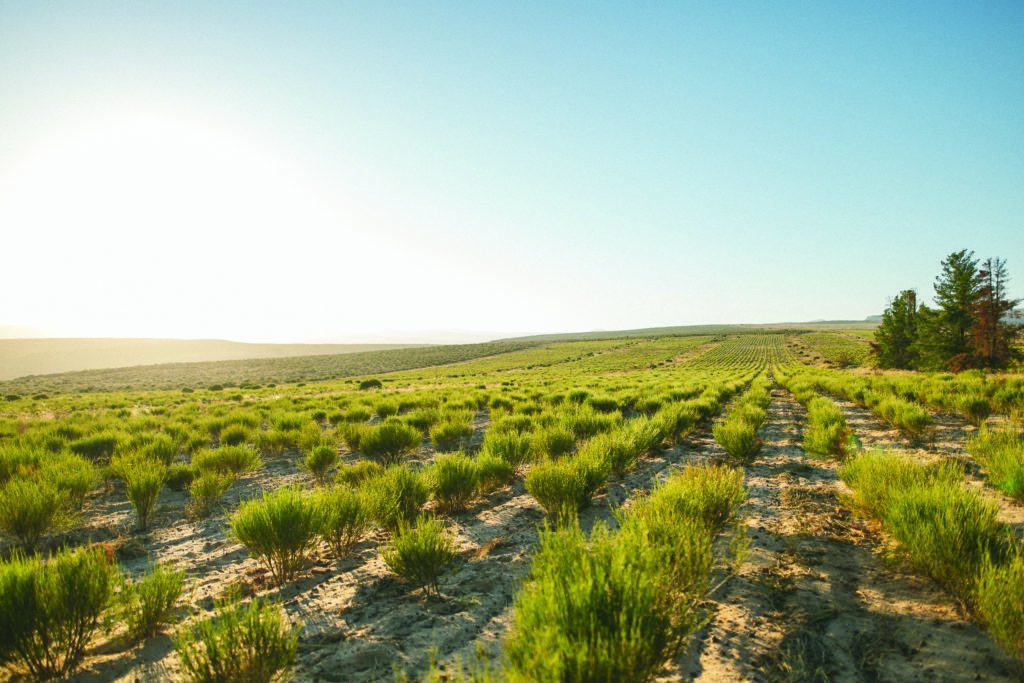
The Commercial Aspect: Is It Profitable To Grow Rooibos Elsewhere?
Given that the South African rooibos industry is successfully supplying (and periodically over-supplying) the global market for rooibos, there is little commercial benefit for farmers in other countries to attempt to grab would-be market share from South African producers.
Added to this, there is considerable local knowledge (which is closely held by rooibos farmers) regarding how to produce and process rooibos tea successfully. This information and know-how is not readily accessible to farmers in other countries. Successful rooibos farming and processing is complex and not easily replicated, even within South Africa in the right regions by farmers who lack the know-how.
Contributing to this picture is the fact that South Africa is a developing world country with a relatively weak currency. This potentially means that even if it could be grown in other parts of the world, it is likely that regions would not be able to successfully compete with South African producer prices.
An added barrier to the commercial cultivation of rooibos elsewhere in the world is that of intellectual property and bio-prospecting. In terms of international laws regulating the protection of indigenous resources, it is illegal to export seed, seedlings and cultivation of species that are protected by the Convention on Biological Diversity, which is an international agreement binding on all member states of the United Nations that came into effect in 1993.
Added to this protection, the South African government itself has a number of regulations in place which similarly seek to protect indigenous resources, among which are the National Environmental Management: Biodiversity Act, 2004, and the Bioprospecting, Access and Benefit Sharing Regulations issued under that Act in 2008, and Section 30 of the Patents Act, 1978, as amended by the Patents Amendment Act, 2005.
A Proudly And Uniquely South African Herbal Tisane
Attempts to grow rooibos outside of its home range have been made in Argentina, the USA, China and Australia. None have succeeded, and on the basis that as a uniquely South African plant it should be protected from biopiracy, there is a reasonable case for supporting the idea that rooibos should not be grown elsewhere in the world.
After all, being endemic to South Africa and having been used herbally and as a tea for centuries means that rooibos is an iconic part of the material heritage and culture of South Africa. This is recognised by the Protected Designation of Origin status awarded by the EU and other protections that, much like provenance and terroir indicators for a wide variety of agricultural products worldwide, deserve protection.
As it stands, rooibos as a South African plant is the cause of significant pride as a unique and beneficial plant that provides not only a very tasty cup of tea, but also a wide range of health benefits for the whole world.
References:
- Rhizobial diversity and function in rooibos (Aspalathus linearis) and honeybush (Cyclopia spp.) plants: A review C. Brink, A. Postma, K. Jacobs (South African Journal of Botany, Volume 110, May 2017, pages 80 – 86)
- The effect of residue management on the nutrient cycle in the production of rooibos (Aspalathus linearis) at Nieuwoudtville, Northern Cape S.Nieuwoud (Stellenbosch University, March 2017)

